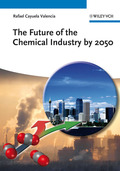The Future of the Chemical Industry by 2050

1. Edition April 2013
X, 340 Pages, Hardcover
30 Pictures
General Reading
Short Description
This book is highly recommended for anyone with an interest in where the future of the chemical industry lies.
Discussing the technological supremacy of the chemical industry, including pharmaceuticals, and how it will adopt a leading position to solve some of the largest global challenges humans have even seen, this book details how the industry will address climate change, aging populations, resource scarcity, globality, networks speed, pandemics, and massive growth and demand.
Following a detailed introduction to some of the megatrends shaping our world over the forthcoming decades, the book goes on to provide several scenarios of how the world could look by 2050, including 'business as usual' and a 'sustainable' one. Chapter 3 gives a comprehensive overview of the current status, while providing a short historical review of the chemical industry, its origins, achievements and fundamentals. The following chapter reviews the potential impact of each of the selected megatrends on the industry, while Chapter 5 proposes how it could look by 2050. Several features of the chemical industry are presented and discussed, including the industrial relevance from an economical, technological and profitability point of view. The largest chemicals markets in absolute and per capita bases and the areas and countries with largest growth potential for chemicals, pharmaceuticals and feedstock. This chapter also reviews the impact of climate change on the chemical industry from a feedstocks and products point of view and, more specifically, the potential costs in reducing CO2 emissions. A final, concluding chapter summarizes the forthcoming megatrends and potential challenges, opportunities and the outlook for the industry as a whole.
GLOBAL MEGATRENDS BY 2050
Social Megatrends
Economic Megatrends
Political Megatrend
Energy Megatrends
Climate Change
Wild Cards
Accelerators - Information Technology and `'Singularity'
THE WORLD BY 2050
'A Much Larger, Wealthier, Healthier, and Sustainable World'
Status of the World - 2010
The World in 2050
THE CHEMICAL INDUSTRY IN 2010
Chemical Industry: Economic Relevance
Chemical Industry: Technological Relevance
Industry Relevance: Profitability
Feedstocks and Energy
Major Sectors and Products of the Chemical Industry
Industry Structure and Companies
Safety
Background
Conclusion
Summary - Industry Major Features and Upcoming Megatrends
Major Features of the Chemical Industry
IMPACT ASSESSMENT OF THE GLOBAL MEGATRENDS ON THE CHEMICAL INDUSTRY
Introduction
Megatrends with the Highest Impact into the Chemical Industry (Global & Area Level)
Megatrends with the Highest Impact in the Industry (Area Level) - (Figure 4.4)
Megatrends with the Highest Impact into the Different Features of the Industry
Major Results for the Chemical Industry Globally
Major Results for the Chemical Industry in the ADV Economies
Major Results for the Chemical Industry in the BRIC Economies
Major Results for the Chemical Industry in the REST Economies
THE CHEMICAL INDUSTRY BY 2050
Introduction
Feature 1: The Relevance of the Chemical Industry
Feature 2: Inputs - Feedstocks
Feature 3: Outputs - Products
Feature 4: Climate Change - Greenhouse Emissions - CO2 Emissions
Feature 5: Industry Structure
Feature 6: Social Awareness
CONCLUSION
INDEX
in Business and Economics from the university Complutense in Madrid, Spain and Wolverhampton in UK, a Masters degree in European Economics from the College of Europe, Brugge, Belgium and an Executive MBA from The University of Chicago, USA and an MBA from the Dow
Chemical & Northwood MBA, Michigan, USA. Rafael Cayuela has worked for The Dow Chemical Company in Madrid, Spain, Dow global
headquarters in Midland Michigan and Dow European Headquarters in Horgen, Zurich, Switzerland. Since 2010 Rafael Cayuela works as
the global product and marketing director for STYRON, a spin off company of Dow Chemical. In its current work for the last years Rafael has
been gathering signifi cant experience in petrochemicals, plastics and synthetic rubber around the world and specially in emerging markets;
in particular in China, Korea, Indonesia, Brazil and India..


